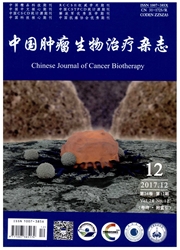

 中文摘要:
中文摘要:
目的:采用原代培养的方法建立一株人肝癌细胞系EH-H1,并对其生物学特性进行分析。方法:将取自东方肝胆外科医院诊断为原发性肝细胞癌的组织标本分离成单细胞悬液,用含10%胎牛血清的DMEM培养液进行原代和传代培养,在普通显微镜以及电子显微镜下观察细胞的形态,并绘制细胞的生长曲线。用放射免疫法检测细胞系AFP和HBV的含量,采用染色体G显带方法进行细胞染色体核型的分析,裸鼠皮下接种细胞检测该细胞的成瘤能力。结果:成功建立一株新的人肝癌细胞系,命名为EH-H1。EH-H1细胞体外连续传代80代以上,细胞形态不变,生长周期恒定在24 h。放射免疫检测EH-H1各代细胞HBV均为阴性,AFP分泌微量(0.6μg/L)。染色体G带显示,EH-H1细胞染色体为非整倍体,以超2倍体为主。该细胞经皮下接种可使裸鼠致瘤(10/10),移植瘤病理组织学类型和分化程度与肝细胞癌一致。结论:通过原代培养建立的肝癌细胞系EH-H1与原发癌保持相似的生物学特性,可望成为一个稳定的细胞系。
 英文摘要:
英文摘要:
Objective: To establish a human hepatocellular carcinoma cell line EH-H1 by primary cuhure and to investigate its biological characteristics. Methods: Tumor tissues obtained from patients treated in our hospital were made into single-cell suspension and were primary cultured, passaged in DMEM medium supplemented with 10% fetal bovine serum. The morphology of the cells was observed under light and electronic microscope ; the cell growth curve was plotted. Radioimmunoassay was employed to examine the AFP and HBV expression. Cytogenetic study was performed with the cell line using G-banding chromosome analysis. The tumorigenicity of the cell line was studied in nude mice by subcutaneous injection. Results: We have successfully established a novel hepatocellular carcinoma cell line EH-H1, which could be passaged for over 80 generations with unchanged morphology and growth cycle (24 h). Radioimmunoassay resuhs demonstrated that all EH-H1 cells were HBV negative with slight AFP expression (0.6 μg/L). G banding results indicated that EH-H1 cells were aneuploid cells, primarily hyperdiploid. Tumors were formed in all the 10 mice subcutaneously inocula- ted with EH-H1 cells. The pathological types and differentiation degrees of the newly formed tumors were identical to their parental hepatocellular carcinoma. Conclusion: The established EH-H1 cell line in this study maintaines the biologic characteristics of its original carcinoma, and might be a stable cell line of human hepatocellular carcinoma.
 同期刊论文项目
同期刊论文项目
 同项目期刊论文
同项目期刊论文
 期刊信息
期刊信息
